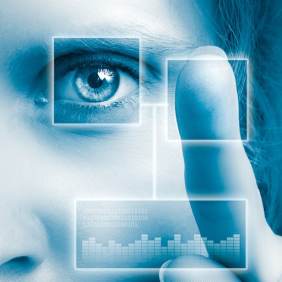Despite its screen-worthy characteristics, biometrics is a science that's based on precise mathematics. By using strict measuring procedures to make sense of a person’s identity, biometrics is a trustworthy mechanism for access control systems.
In contrast to Behaviometrics (measuring patterns in human physical activity), biometrics finds patterns in various body features. Some like to attribute voice recognition to behavioral measures while connecting face recognition to the wider scope of general biometric measures.
Voice recognition and face recognition are now getting almost as accepted as fingerprints, and thermal scanning is becoming more popular, too.
When you say that the access to your home or your company building is controlled by biometrics, it means that the readers measure face distortions, finger whorls, or voice parameters to let the biometrics access control equipment know that the person requiring entrance is an individual with genuine access and not an intruder.
Face Recognition and Voice Recognition in Biometrics #
Simply put, novel biometric measures, such as face or voice recognition, belong to the safety authentication measures related to what the user is. For comparison purposes, PINs and passwords are an authentication factor the user knows, while tokens and FOBs are something the user owns.
Biometrics access control systems can cement the weak spots of the former two factors or just provide an extra level of protection. Some banking industries rely heavily on biometrics, including it as a part of their 2-factor authentication. Without a doubt, biometrics is an irreplaceable security mechanism for commercial and residential applications, particularly for large areas. It can be customized in dozens of ways to adjust to the nature of your business and your employee needs. This is equally important for different safety levels and for adaptation to the technical characteristics of the terrain.
Thermal Scanning in Biometrics #
The newest layer of biometrics-based security is thermal scanning, which measures body temperature and will not let a person in if they are above a certain threshold. This is often used along with face recognition for identity detection, or in some cases, the user can only unlock the door with their keycard or passcode if they first pass the temperature screening. This has become increasingly important for businesses during the COVID-19 pandemic to keep their employees as safe as possible and lower the spread of the virus. Many businesses have also employed this measure to check the temperature of visitors as well, without using identity detection with it.
Thermal scanning not only helps protect your office from illness, but it also works seamlessly with cloud-based access systems like Kisi as an additional layer of protection for your space. Unfortunately, they often require the addition of face-scan terminals, meant for facial recognition, as biometrics measurement features come with these devices rather than as standalone options.
How Safe Is Biometrics in Access Control #
An average person has about 25 accounts that require passwords. Hardly anyone uses the same one for each account. Even if it is only one, forgetting your password is downright annoying, not to mention dangerous. What if you forget your passcode and the building you need to exit from is on fire? Although not impossible, let’s put worst-case scenarios like these aside and concentrate on how biometrics works. This can help you decide between the appropriate access control models for your premises.

The blood vessels in your eyes and the whorls at the tip of your fingers make you one of a kind. No other person in the world shares exactly those peculiarities. The eye veins are just one measure a biometric reader can use to examine your unique features and provide access to a building. The shape of certain features of your body, including irises and retinas, palm print and veins, and even your heartbeat are all physiological aspects of your identity that can be biometrically measured.
Regardless of how undignified this may sound, you can be measured and labeled almost like an object. The distinct measurement mechanisms used in biometrics surpass the forgetfulness and the sharing of traditional authentication systems. After all, you can’t forget or share your face or your voice, as you can do with a token or a passcode. The biometric data stored in the access control system is later used for authentication.
The Sense Behind Biometric Measures #
Biometric measurement is more like mapping your face than taking a photo of your face. The biometric scanner digitizes thousands of points, distances, and proportions of your facial distortions. For example, it will compare distances between your chin and your forehead or locate where exactly is your nose.
It will look for patterns in the finger whorls or, in the case of voice recognition, discover the unique shape of a person’s mouth or throat to confirm identity. Speaker or voice recognition can include an additional security benefit—text-dependent elements, such as a passphrase. This is not only discovering a speaking pattern, but also almost a second voice password.

Regardless of the method of data collection, biometric scanners make sense of a person’s identity by transforming the measures into numbers. The numbers are then run across a database of previously enrolled measures for authenticated users. So, yes, in a way, with biometrics, each person gets turned into a number, which, in terms of access control, is a good thing. Especially if you need to set unique identity authentication for large businesses with several physical or personal security layers.
Pros and Cons of Biometrics-Based Access Control #
Here are just a few of the benefits of using biometrics to safeguard access at work:
- Increase productivity by eliminating system inaccuracies
- Enhance employee accountability
- Track excessive overtime
- Provide top-notch integration capacity
- Enable multifactor authentication with voice and face recognition
- Multimodal authentication with multiple data enrollments
For the most part, the advantages of biometrics in access control systems widely surpass the assumed vulnerabilities. Almost none of the alternative access control options are so versatile, universal, and well-performing.
However, there are some privacy concerns that come with the increased use of biometrics in access control. For one, many people aren't sure how much personal information they're generally willing to disclose, or how their private data is used, and biometrics adds another layer to the data being collected and shared. Some are worried that collecting sensitive data like fingerprints, voices, and facial scans will allow that data to be used maliciously in the future.
Another issue regarding privacy is that in the case of a data breach, biometrics can't be changed the way a password can be: Our fingerprints, voices, and iris patterns are permanent.
On the more tangible side, like any new AI technology, these devices aren't always accurate, which can lead to unauthorized people being allowed into a facility. Some devices can also take longer than traditional access control to let someone in, which can be a problem if many employees are showing up at the same time for the workday.
Biometric access control features are permanent and measurable, thus making the access control systems that use them super-applicable over space and time. While we are getting used to having our faces and voices measured, scientists are already working on expanding the biometrics potential to additional human modalities, such as EEG and ECG... It is a matter of a heartbeat.
Clearly, biometric devices have a number of advantages but should be used with caution. If you're considering using biometric measures with your access control system, carefully consider how it will impact your business and if it's the right decision for your business before you take the plunge. For many, though, mobile access control—combined with biometrics or as a standalone system—are a great option. With Kisi, you can get the best of both in a way most people are comfortable with: Using Kisi's cloud-based access control to unlock facility doors with Kisi's mobile app, which people use fingerprint or face recognition to access on their phone.

